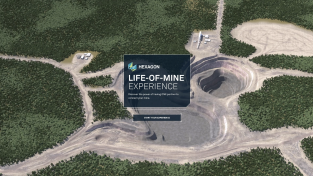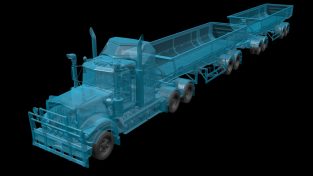In this HxGN Radio episode, we discuss how Hexagon Mining’s new short term planning scheduling technology, Atlas 3.0, will assist in creating an optimised product blend, taking into account material and grade constraints. To listen to more HxGN Radio episodes, visit our channels on iTunes, SoundCloud or Stitcher.
Welcome to HxGN Radio. This is your host, Neville Judd. Thank you for joining us for today’s podcast episode brought to you by Hexagon Mining. In today’s podcast we’re talking to Verne Vice, who is technical sales specialist at Hexagon Mining. Hexagon Mining is the only company to solve surface and underground challenges by integrating design, planning, and operations technologies for safer, more productive mines. The company delivers a mine planning solution to solve challenges at every stage of the planning process. Atlas, its activity-based scheduler, has added blending optimization to help planners create an optimized product blend that meets mine requirements.
NJ: Verne, thanks very much for joining us today.
VV: No worries Nev. Good to see you and join you.
NJ: So Verne, tell us a little bit about your role at Hexagon Mining.
VV: Okay Nev. So as a member of the technical sales group my role and responsibility is to provide our clients with enough information for them to make an informed decision on buying our products. We also work very closely with the developers just to make sure that client ideas get into our products, and that our products are ready for the market and provide what the market requires.
NJ: Tell us about the challenges of short-term scheduling?
VV: Okay. With short-term scheduling there’s quite a few challenges. Because it’s short-term that means the deadlines are tight so there’s a lot of pressure on planners to get schedules out in a very short timeframe. The targets at the short-term level are very tight as well, so the mill wants a constant feed of material to process so that shipments can be made. Mining, in itself, is very risky as well. So a bad plan could lead to wall failures which could endanger people. So as a short-term planner you’re trying to free up as much time as possible just to make sure everything you produce in your schedule is correct. In the current economic market as well it becomes even tougher, because commodity prices are low, and short-term planners are starting to feel some of that as well. The higher ups at their companies want to see maximum utilization of their equipment and reduce costs. So we try to give them a tool that makes everything much easier.
NJ: Right. So Atlas was created with short-term scheduling in mind. Tell us a little bit about Atlas and the latest improvements.
VV: Yeah. So Atlas was designed for the short-term scheduler. So at a short-term level there’s more than one activity that needs to be managed in a plan. So you’ve got your drilling, your blasting, your mining. You’ve also got other activities as well like construction dewatering. All these activities have to be scheduled in a short-term plan. So Atlas was released 2 years ago and we’ve constantly been adding features since its release. We’ve put it in the marketing and clients have given us feedback, and now we’re at a level where it’s a fully developed product that has more than you need to do your job. With the latest improvement in Atlas, what we’re doing is introducing CPLEX. So CPLEX is a solving language. What it does is it mathematically solves an optimized solution for you. So the problem that we’re giving it, in Atlas, is the problem of reclaiming material from our stockpiles to create a blend that suits what the mill needs. As a user this will free up a lot of your time because you’re not having to mix and match different reclaim amounts and play with that. The tool will solve that problem for you.
NJ: Right. So can you maybe just elaborate a little bit on that? How will users benefit from optimized blending and some of the other improvements?
VV: Yeah. So it takes a lot of prerequisite steps for the mill to get the feed that they require. So most mines will build up different stockpiles containing different cutoffs of material based on mineralization, contaminates, and grade quality. And they’ll manage these and have the volumes recorded, the grade at the stockpiles recorded as well. And as a planner your job is to fill these stockpiles and then reclaim from these stockpiles to your mill. So you don’t always know how much you need from each of these stockpiles to meet what your mill requires. With Atlas what we’re doing is we’re taking that responsibility away from the planner. You set your target for the mill and Atlas will actually reclaim the amount that you need from your stockpiles. So as a short-term planner, this is freeing up that time you would have spent just fiddling with your schedule, giving you more time to create more scenarios, and perhaps improve the schedule that you produce. And also the time that you take to produce your schedules as well.
NJ: Is there anything else like this on the market?
VV: No so this is the only all-in-one tool encompassing Gantt scheduling, material routing, visualization in a 3D environment, and reporting in a single package. We’re also unique because it’s a one-purchase component. So you buy a component, which is Atlas, and you get everything included. You don’t have to buy a lot of add-ons to get all this functionality. It all comes in the same tool.
NJ: So why didn’t Hexagon Mining do this sooner?
VV: Hexagon Mining has always had a large focus on mine planning and Scheduler Optimizer, which is another one of our products, has been the industry’s prime scheduler for optimization. So when Atlas was introduced, the idea was to get it out the gate with all of the manual functionality that it requires for short-term planners to do their job. We always wanted to include some level of optimization into Atlas, but because we had an existing product they could sort of live side-by-side with each other. As time has gone by we’ve had the development time to put CPLEX in, and it’s always the next logical step to put blending into Atlas. It’s just a matter of time really, and we’ll continue to add features to Atlas.
NJ: Now you mentioned the Schedule Optimizer, tell me a little bit about the synergies between Atlas and Schedule Optimizer and the potential for more integration there?
VV: So Scheduler Optimizer, what that was designed for was to allow users to put in economic constraints and spatial constraints and let the tool decide what the best extraction sequence is. So the best digging sequence for your mine to accomplish the best net present value. At a manual level, where Atlas is… so short-term, that flexibility in your schedule is not always feasible. So the synergy comes in between the tools where you can optimize your digging sequence within MSSO or MineSight Schedule Optimizer (paused 8:04) plus that optimized digging sequence into Atlas. They’ll dig it the same way but fit in other activities around your digging. So now you’re scheduling your drilling and your blast activities alongside your digging. So you get a more accurate understanding of when those activities actually take place. With that slightly adjusted sequence the stockpile balance will change as well, and then again we need to blend our stockpiles to get our product at the end. It also works the other way. So if you work from the bottom level of the lowest level up to a high-level schedule 8:41, you can create your budget plans within Atlas that are very detailed. Look at where your very detailed plan is ending in the next year, the next 2 years, and the next 5 years, pass that information onto MineSight Schedule Optimizer and, then use that as a starting point for the rest of your life of mine schedule. It’s really about integrating all of the separate planning silos into one cohesive and one flowing, planning process.
NJ: And that very much embodies Hexagon Mining’s overall vision, I guess, of integration and a life of mine solution. Last question Verne, where do you see Atlas going from here?
VV: So we have a lot of plans with focus in several different areas. First off, Atlas is also our underground scheduling tool. So we have a lot of cool new features that have been added in to improve design of underground developments and scheduling of them as well. So that will come in the short term. What we’re also looking at is just a more seamless integration with our other products. So Hexagon Mining has a range of products that accomplish a lot. So we want to integrate and tap into that power and bring it into the manual scheduling world. So you’ll see that existing integrations like SO (Schedule Optimizer), like Hexagon Mining Blast, like Hexagon Mining Athena will improve, and you’ll get a better experience out of that. What we’re also introducing is more operational integration. So reporting back from the operational level through to your planning just to give you an idea of how that plan was executed. So you can review your planning process and make adjustments. We’re also looking at integrating with third party equipment maintenance schedulers, so that we can bring maintenance schedulers from third party tools into Atlas, and you can use those existing maintenance schedulers seamlessly. There’s also a host of improvements that we’re doing to the workflow and experience. These come with time in any software, so planners always have feedback, and we’re happy to put in improvements that will improve the workflow for everyone.
NJ: Exciting times ahead. Verne thanks very much for joining us today.
VV: Always glad to jump on with you Nev.
So we would like to thank Verne for being our guest today. To our listeners, you can learn more about Atlas at hexagonmining.com. Tune in to more episodes from HxGN Radio on iTunes, SoundCloud or Stitcher Radio. Thanks for listening.













![[PODCAST]: Optimised Planning for Optimised Output](https://blog.hexagon.com/wp-content/uploads/2016/03/artworks-000151521927-q5o1b8-t500x500-500x391.jpg)



